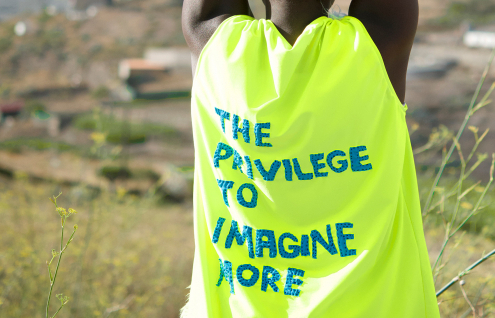Sistershoop
Alicia Framis

Sistershoop
Alicia Framis
Amsterdam, 29 Oct - 17 Dec '22
Opening 29 October, 17.00 - 19.30 h
Upstream Gallery proudly presents Sistershoop, Alicia Framis’ second solo exhibition with the gallery.
Sistershoop builds on Framis’ fascination with human existence within contemporary urban society, in which overstimulation and inequality are, unfortunately, omnipresent. Framis especially aims to direct attention to the mental and physical states of women in this society. Through various media like video, sculpture, and installation, different stories concerning uncertainty and inequality are depicted within this exhibition.
Once upon a time there was a woman
As gender archeology is slowly unmasking the social construction of gender identities of the past, it is becoming clear that women were not just passive participants. Yet women still face and have to deal with this misunderstanding in current society.
By placing the typical representation of femininity and fertility, a venus, in all forms and shapes on a pedestal with their power stunted by a glass ceiling above them, the artist creates a symbol of women throughout the history of humanity. With the use of humor, Alicia Framis denounces the situation in which women are and have been, and strives for a more equal world for everyone.?
“The glass ceiling”—an expression used for the first time in 1978—is artificial, addressing an invisible barrier in women’s professional careers. The invisible glass curtails and limits women’s aspirations and opportunities. Now, in 2022, forty-four years after the coining of the expression “The glass ceiling”, what has actually changed for women over the intervening time?
The walking ceiling
In the video work The Walking Ceiling (2018), a glass plate is once again used as the clear metaphor for the position of women in society. This time defending a new design of leadership power, which will not exclude access to women.
A glass plate, measuring 2 by 3 meters, is placed over the heads of professional women from Madrid, who Framis has asked to help her carry it through the streets of the city. The plate was supported using a piece of padded cloth or silicone, so that glass does not slip and also to cushion vibrations. The movement of the glass plate through the city, carried by these women, is silent yet also aggressive. The action is part of the artist’s search for new, truly feminine ways for women to protest: though without imitating masculine attitudes or symbols.
Absalon in Cuba
With the work Absalon in Cuba (2017) the artist specifically draws attention to the current state of women living in Cuba. The photo print shows a dress that consists of 570 nanas (aluminum scourers) functions as Framis' absurd act to protect the unprotected. The scourers in this dress symbolize the absurdity of the impossibility of protecting oneself in a house without protective laws regarding women. To find security between the walls of the house, like the elephant that hides behind the mouse to mislead its enemy, women protect themselves in their kitchens with scourers, nails, and teeth.
Sistershoop
Alicia Framis often uses textiles in all forms to reflect on their different meanings and usage throughout history. Within the Sistershoop project, she focuses on the invisibility of women's sports practice. The project is the result of the artist’s research process and dialogue with groups of female basketball players in Gran Canaria. Through this project the artist wants to question and demand equal rights for sports women using clothing as the medium for her critique. The artist collaborated with a group of women, of different ages, who are part of the female basketball team Canterbury Lions of the Canterbury School, a private educational center in Las Palmas de Gran Canaria. For Sistershoop Framis drew, amongst other literary works, from the manifesto Glitch Feminism, written by curator and writer Legacy Russell.
Insomnia
With fluorescent paintings, made with the tape used in airplanes to show passengers the way in the dark, the artist addresses one of the most common bodily manifestations of fear and uncertainty: insomnia. The presented paintings serve as accompaniment in nights of wakefulness, reflecting the phrase ‘Leave Here Your Fears’.

